NOAA 200th Postcards from the Field May 2007
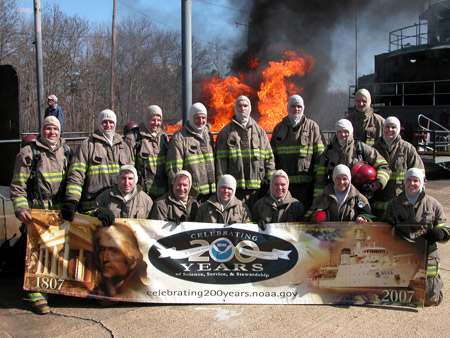 Before heading back to sea later this year, NOAA Corps officers took part in refresher training classes in
advanced fire fighting. The nearly month-long course at the Merchant Marine Academy strengthens leadership skills, reviews ship operations, and leads to renewal of U.S.
Coast Guard certification. Shown (rear, from left): Lieutenant Hector Casanova, Commander Don Haines, Commander Tod Schattgen, Lieutenant Commander Rick Brennan,
Lieutenant Jake Yoos, Lieutenant Monty Spencer, Lieutenant Bryan Wagonseller, Lieutenant Commander Joe Pica, and Lieutenant Commander Cecile Daniels. Shown (front,
from left): Lieutenant Dan Simon, Lieutenant Commander Rick Fletcher, Lieutenant Stephanie Koes, Lieutenant Sarah Mrozek, Lieutenant Natasha Davis, and Lieutenant,
Junior Grade Kelley Stroud.
Before heading back to sea later this year, NOAA Corps officers took part in refresher training classes in
advanced fire fighting. The nearly month-long course at the Merchant Marine Academy strengthens leadership skills, reviews ship operations, and leads to renewal of U.S.
Coast Guard certification. Shown (rear, from left): Lieutenant Hector Casanova, Commander Don Haines, Commander Tod Schattgen, Lieutenant Commander Rick Brennan,
Lieutenant Jake Yoos, Lieutenant Monty Spencer, Lieutenant Bryan Wagonseller, Lieutenant Commander Joe Pica, and Lieutenant Commander Cecile Daniels. Shown (front,
from left): Lieutenant Dan Simon, Lieutenant Commander Rick Fletcher, Lieutenant Stephanie Koes, Lieutenant Sarah Mrozek, Lieutenant Natasha Davis, and Lieutenant,
Junior Grade Kelley Stroud.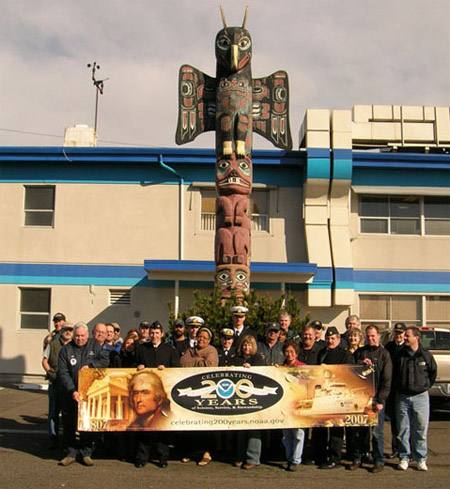 Greetings from the Marine Operations Center-Pacific (MOC-P) on Lake
Union in Seattle, Washington, where MOC-P civilians and NOAA Corps officers are responsible for the day-to-day operations, management, and maintenance of NOAA research
and survey ships operating from ports along the West Coast, Hawaii, and Alaska. Supporting 10 NOAA fisheries, oceanographic research, hydrographic survey, and
multi-disciplinary ships are (from left): Steve Ralson, Larry Loewen, Bill Brandenburg, Ron Daum, Clay Norfleet, Joe Roessler, Margie Schliebe, Jennifer Carriere,
Larry Wooten, Lieutenant Dan Simon, Vince Welton, Lieutenant Commander Will Foust, Carol Martin, Captain Jane Powers, Lieutenant Mark Miller, Sandy Mezger, Mike Borries,
Jennifer Davis, Bob Blackburn, Violeta Yee, Jim Schell, Captain John Rix, Commander Frank Wood, Bob Wilmot, Joan Langhans, Todd Irby, Commander Michael Devany, and Frank
Coluccio.
Greetings from the Marine Operations Center-Pacific (MOC-P) on Lake
Union in Seattle, Washington, where MOC-P civilians and NOAA Corps officers are responsible for the day-to-day operations, management, and maintenance of NOAA research
and survey ships operating from ports along the West Coast, Hawaii, and Alaska. Supporting 10 NOAA fisheries, oceanographic research, hydrographic survey, and
multi-disciplinary ships are (from left): Steve Ralson, Larry Loewen, Bill Brandenburg, Ron Daum, Clay Norfleet, Joe Roessler, Margie Schliebe, Jennifer Carriere,
Larry Wooten, Lieutenant Dan Simon, Vince Welton, Lieutenant Commander Will Foust, Carol Martin, Captain Jane Powers, Lieutenant Mark Miller, Sandy Mezger, Mike Borries,
Jennifer Davis, Bob Blackburn, Violeta Yee, Jim Schell, Captain John Rix, Commander Frank Wood, Bob Wilmot, Joan Langhans, Todd Irby, Commander Michael Devany, and Frank
Coluccio.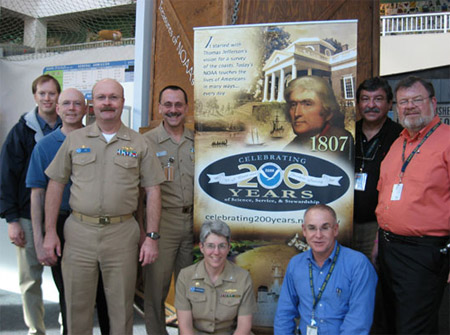 Taking a break at a management meeting held at NOAA's
Marine Operations Center-Pacific, NOAA Corps officers and civilians from NOAA's Office of Marine and Aviation Operations toured the Treasures of NOAA's Ark exhibit at
Seattle's Pacific Science Center. Shown (from left): Doug Smith, Mitch Luxenberg, Captain Jon Rix, Rear Admiral Richard Behn, Captain Emily Christman, Doug Friske, and
Captain Jack McAdam.
Taking a break at a management meeting held at NOAA's
Marine Operations Center-Pacific, NOAA Corps officers and civilians from NOAA's Office of Marine and Aviation Operations toured the Treasures of NOAA's Ark exhibit at
Seattle's Pacific Science Center. Shown (from left): Doug Smith, Mitch Luxenberg, Captain Jon Rix, Rear Admiral Richard Behn, Captain Emily Christman, Doug Friske, and
Captain Jack McAdam.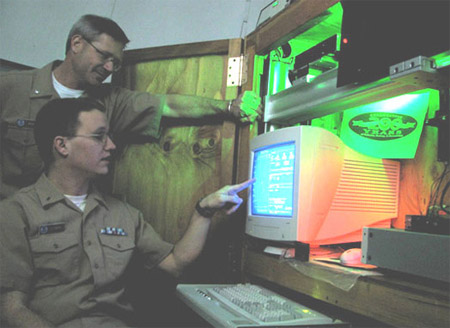 Lieutenant, Junior Grade Andrew P. Seaman (seated), of NOAA Research's Earth System Research
Laboratory, and Commander John J. Adler look at how aerosol particle detecting Laser Imaging Detection and Ranging (LIDAR) works at the Global Monitoring Division atop
the NOAA facility in Boulder, Colorado. To provide a greater understanding of the Earth's composition, and therefore of climatic conditions, a green laser is directed
50 kilometers into the sky where it reflects off pollutants in the atmosphere and reveals the pollutants' concentration at different altitudes. To accurately record the
seasonal fluctuation of particles, this measurement is done year-round for one hour every 5-10 days. In addition to operating LIDAR, the Global Monitoring Division
records atmospheric conditions at stations at the Galapagos Islands, the South Pole, and in Brazil, Algeria, and Indonesia, among other sites.
Lieutenant, Junior Grade Andrew P. Seaman (seated), of NOAA Research's Earth System Research
Laboratory, and Commander John J. Adler look at how aerosol particle detecting Laser Imaging Detection and Ranging (LIDAR) works at the Global Monitoring Division atop
the NOAA facility in Boulder, Colorado. To provide a greater understanding of the Earth's composition, and therefore of climatic conditions, a green laser is directed
50 kilometers into the sky where it reflects off pollutants in the atmosphere and reveals the pollutants' concentration at different altitudes. To accurately record the
seasonal fluctuation of particles, this measurement is done year-round for one hour every 5-10 days. In addition to operating LIDAR, the Global Monitoring Division
records atmospheric conditions at stations at the Galapagos Islands, the South Pole, and in Brazil, Algeria, and Indonesia, among other sites.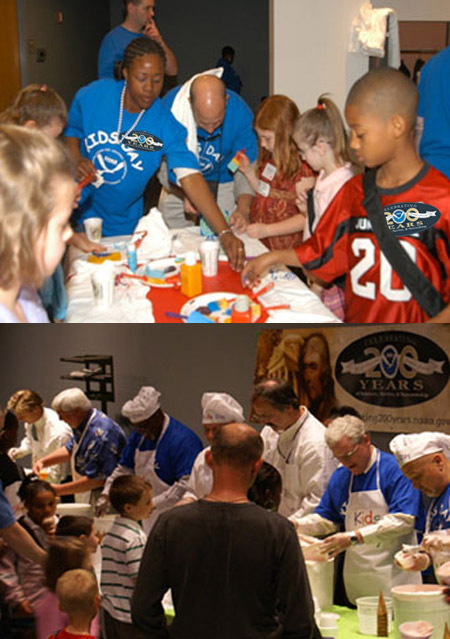 NOAA's Kids' Day on our Silver Spring, Maryland campus grows bigger each year, and this year was no
exception. Nearly 600 kids and about 150 of our staff pitched in to make NOAA's Kids' Day a fun, educational (and delicious) event. Twenty-six workshops for various
age groups ranged from Fishy Business, All Knots and Squid Stuff, to Oil and Water, Climate Change, Pick the Poles, and Earth From Space. Special activities were
developed for kids under 7. You can enjoy the success of these activities and many others at http://www.kidsday.noaa.gov. Thanks to Al Corea and Helen Buggs of NOAA's Civil
Rights Office for over-all direction and to everyone who helped craft this outstanding NOAA event.
NOAA's Kids' Day on our Silver Spring, Maryland campus grows bigger each year, and this year was no
exception. Nearly 600 kids and about 150 of our staff pitched in to make NOAA's Kids' Day a fun, educational (and delicious) event. Twenty-six workshops for various
age groups ranged from Fishy Business, All Knots and Squid Stuff, to Oil and Water, Climate Change, Pick the Poles, and Earth From Space. Special activities were
developed for kids under 7. You can enjoy the success of these activities and many others at http://www.kidsday.noaa.gov. Thanks to Al Corea and Helen Buggs of NOAA's Civil
Rights Office for over-all direction and to everyone who helped craft this outstanding NOAA event.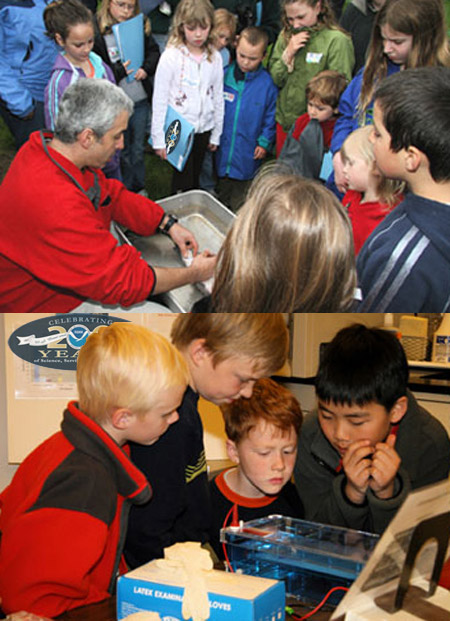 Marking the nationwide "Bring Your Kid to Work Day," NOAA's
Northwest Fisheries Science Center in Seattle, Washington, engaged 35 children of center staff in dozens of hands-on science activities aimed at advancing environmental
literacy and greater understanding of what their parents do each day. Kids learned to dissect fish, run DNA gels, and use tags to count fish. They also observed zebrafish and
microorganisms, toured a hatchery, and watched shark tagging and dive gear demonstrations. Thanks to Deborah McArthur and her outstanding team for organizing the day.
Marking the nationwide "Bring Your Kid to Work Day," NOAA's
Northwest Fisheries Science Center in Seattle, Washington, engaged 35 children of center staff in dozens of hands-on science activities aimed at advancing environmental
literacy and greater understanding of what their parents do each day. Kids learned to dissect fish, run DNA gels, and use tags to count fish. They also observed zebrafish and
microorganisms, toured a hatchery, and watched shark tagging and dive gear demonstrations. Thanks to Deborah McArthur and her outstanding team for organizing the day. 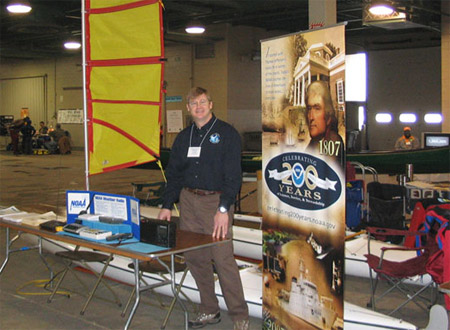 The Weather Forecast Office in Grand Rapids, Michigan, recently participated in the "Quiet Waters
Symposium" in Lansing, where the focus was on human-powered outdoor recreation equipment and activities throughout the Great Lakes region. An exhibit highlighted NOAA
Weather/All-Hazards Radio and NOAA's 200th Celebration, and NOAA hydrologist Mark Walton delivered a presentation about weather safety for canoeists and kayakers.
The Weather Forecast Office in Grand Rapids, Michigan, recently participated in the "Quiet Waters
Symposium" in Lansing, where the focus was on human-powered outdoor recreation equipment and activities throughout the Great Lakes region. An exhibit highlighted NOAA
Weather/All-Hazards Radio and NOAA's 200th Celebration, and NOAA hydrologist Mark Walton delivered a presentation about weather safety for canoeists and kayakers.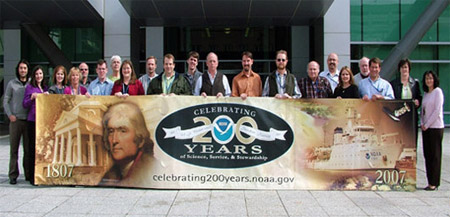 200th celebration greetings arrived from National Weather
Service Western Region Headquarters, which provides support and oversight for 24 Weather Forecast Offices, 4 Center Weather Service Units, and 3 River Forecast
Centers in eight western states. Shown (from left): Aaron Sutula, Jenna Meyers, Dee Wolf, Tina Mace, Bob Tibi, David Myrick, Susan Nelson, Andrea Bair, Mike Doney,
Karl Foster, Ken Pomeroy, Steve Keene, Brian Sadler, Gar Nelson, Bill Dimmick, Roger Lamoni, Diane McArthur, Andy Edman, Steve Brueske, Vickie Nadolski, and
Claudia Cox.
200th celebration greetings arrived from National Weather
Service Western Region Headquarters, which provides support and oversight for 24 Weather Forecast Offices, 4 Center Weather Service Units, and 3 River Forecast
Centers in eight western states. Shown (from left): Aaron Sutula, Jenna Meyers, Dee Wolf, Tina Mace, Bob Tibi, David Myrick, Susan Nelson, Andrea Bair, Mike Doney,
Karl Foster, Ken Pomeroy, Steve Keene, Brian Sadler, Gar Nelson, Bill Dimmick, Roger Lamoni, Diane McArthur, Andy Edman, Steve Brueske, Vickie Nadolski, and
Claudia Cox.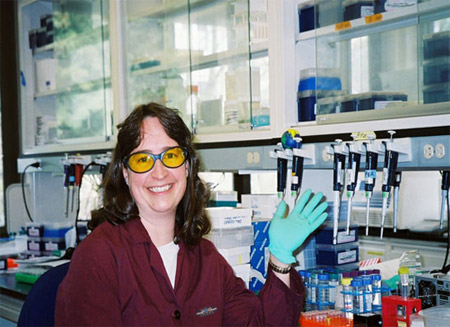 Molecular geneticist Dr. Ewann Berntson and her team at Northwest Fisheries Science Center's Genetics and Evolution
Program (Seattle, Washington) have been performing genetic research on fish (primarily salmon) populations for over 30 years. The research covers many areas, including
monitoring interactions between hatchery and wild populations of salmon using genetic markers, estimating stock composition in mixed-stock fisheries, providing forensic
analyses in support of NOAA Fisheries' Office of Law Enforcement, and developing non-lethal sampling techniques in non-trawlable habitat.
Molecular geneticist Dr. Ewann Berntson and her team at Northwest Fisheries Science Center's Genetics and Evolution
Program (Seattle, Washington) have been performing genetic research on fish (primarily salmon) populations for over 30 years. The research covers many areas, including
monitoring interactions between hatchery and wild populations of salmon using genetic markers, estimating stock composition in mixed-stock fisheries, providing forensic
analyses in support of NOAA Fisheries' Office of Law Enforcement, and developing non-lethal sampling techniques in non-trawlable habitat.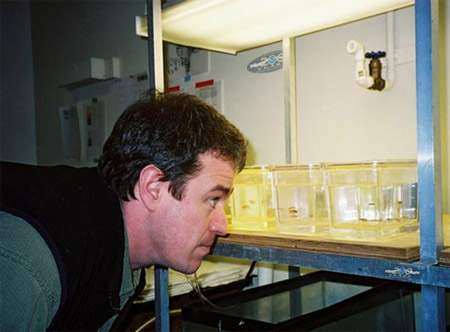 Dr. Nathaniel Scholz leads a Northwest Fisheries Science Center team in Seattle,
Washington, that is conducting groundbreaking research using the zebrafish as a biomedical model to determine the developmental effects of contaminants. Using
innovative techniques and state-of-the art DNA tools, Nat's team demonstrated for the first time that the heart was the major target for polycylic aromatic
hydrocarbons, a contaminant derived from fossil fuels and vehicle exhaust that is highly abundant in the marine environment.
Dr. Nathaniel Scholz leads a Northwest Fisheries Science Center team in Seattle,
Washington, that is conducting groundbreaking research using the zebrafish as a biomedical model to determine the developmental effects of contaminants. Using
innovative techniques and state-of-the art DNA tools, Nat's team demonstrated for the first time that the heart was the major target for polycylic aromatic
hydrocarbons, a contaminant derived from fossil fuels and vehicle exhaust that is highly abundant in the marine environment.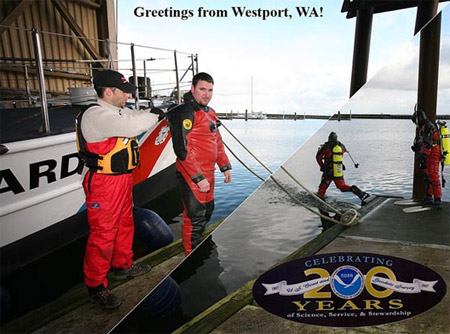 Field crew members from NOAA's Center for Operational Oceanographic Products and Services prepare to
clean and inspect the underwater portion of the tide station at the U.S. Coast Guard base in Westport, Washington. Data from the station support the local Seattle/Tacoma
National Weather Service Forecast Office, the Tsunami Warning Program, climate studies, commercial vessels, the local shellfish industry, recreational boaters and
visitors, local government planners, and emergency management. Shown (from left): Steve Hudziak, Andy Moss, Rolin Meyer, and Andy Moss (again).
Field crew members from NOAA's Center for Operational Oceanographic Products and Services prepare to
clean and inspect the underwater portion of the tide station at the U.S. Coast Guard base in Westport, Washington. Data from the station support the local Seattle/Tacoma
National Weather Service Forecast Office, the Tsunami Warning Program, climate studies, commercial vessels, the local shellfish industry, recreational boaters and
visitors, local government planners, and emergency management. Shown (from left): Steve Hudziak, Andy Moss, Rolin Meyer, and Andy Moss (again).
 Before heading back to sea later this year, NOAA Corps officers took part in refresher training classes in
advanced fire fighting. The nearly month-long course at the Merchant Marine Academy strengthens leadership skills, reviews ship operations, and leads to renewal of U.S.
Coast Guard certification. Shown (rear, from left): Lieutenant Hector Casanova, Commander Don Haines, Commander Tod Schattgen, Lieutenant Commander Rick Brennan,
Lieutenant Jake Yoos, Lieutenant Monty Spencer, Lieutenant Bryan Wagonseller, Lieutenant Commander Joe Pica, and Lieutenant Commander Cecile Daniels. Shown (front,
from left): Lieutenant Dan Simon, Lieutenant Commander Rick Fletcher, Lieutenant Stephanie Koes, Lieutenant Sarah Mrozek, Lieutenant Natasha Davis, and Lieutenant,
Junior Grade Kelley Stroud.
Before heading back to sea later this year, NOAA Corps officers took part in refresher training classes in
advanced fire fighting. The nearly month-long course at the Merchant Marine Academy strengthens leadership skills, reviews ship operations, and leads to renewal of U.S.
Coast Guard certification. Shown (rear, from left): Lieutenant Hector Casanova, Commander Don Haines, Commander Tod Schattgen, Lieutenant Commander Rick Brennan,
Lieutenant Jake Yoos, Lieutenant Monty Spencer, Lieutenant Bryan Wagonseller, Lieutenant Commander Joe Pica, and Lieutenant Commander Cecile Daniels. Shown (front,
from left): Lieutenant Dan Simon, Lieutenant Commander Rick Fletcher, Lieutenant Stephanie Koes, Lieutenant Sarah Mrozek, Lieutenant Natasha Davis, and Lieutenant,
Junior Grade Kelley Stroud. Greetings from the Marine Operations Center-Pacific (MOC-P) on Lake
Union in Seattle, Washington, where MOC-P civilians and NOAA Corps officers are responsible for the day-to-day operations, management, and maintenance of NOAA research
and survey ships operating from ports along the West Coast, Hawaii, and Alaska. Supporting 10 NOAA fisheries, oceanographic research, hydrographic survey, and
multi-disciplinary ships are (from left): Steve Ralson, Larry Loewen, Bill Brandenburg, Ron Daum, Clay Norfleet, Joe Roessler, Margie Schliebe, Jennifer Carriere,
Larry Wooten, Lieutenant Dan Simon, Vince Welton, Lieutenant Commander Will Foust, Carol Martin, Captain Jane Powers, Lieutenant Mark Miller, Sandy Mezger, Mike Borries,
Jennifer Davis, Bob Blackburn, Violeta Yee, Jim Schell, Captain John Rix, Commander Frank Wood, Bob Wilmot, Joan Langhans, Todd Irby, Commander Michael Devany, and Frank
Coluccio.
Greetings from the Marine Operations Center-Pacific (MOC-P) on Lake
Union in Seattle, Washington, where MOC-P civilians and NOAA Corps officers are responsible for the day-to-day operations, management, and maintenance of NOAA research
and survey ships operating from ports along the West Coast, Hawaii, and Alaska. Supporting 10 NOAA fisheries, oceanographic research, hydrographic survey, and
multi-disciplinary ships are (from left): Steve Ralson, Larry Loewen, Bill Brandenburg, Ron Daum, Clay Norfleet, Joe Roessler, Margie Schliebe, Jennifer Carriere,
Larry Wooten, Lieutenant Dan Simon, Vince Welton, Lieutenant Commander Will Foust, Carol Martin, Captain Jane Powers, Lieutenant Mark Miller, Sandy Mezger, Mike Borries,
Jennifer Davis, Bob Blackburn, Violeta Yee, Jim Schell, Captain John Rix, Commander Frank Wood, Bob Wilmot, Joan Langhans, Todd Irby, Commander Michael Devany, and Frank
Coluccio. Taking a break at a management meeting held at NOAA's
Marine Operations Center-Pacific, NOAA Corps officers and civilians from NOAA's Office of Marine and Aviation Operations toured the Treasures of NOAA's Ark exhibit at
Seattle's Pacific Science Center. Shown (from left): Doug Smith, Mitch Luxenberg, Captain Jon Rix, Rear Admiral Richard Behn, Captain Emily Christman, Doug Friske, and
Captain Jack McAdam.
Taking a break at a management meeting held at NOAA's
Marine Operations Center-Pacific, NOAA Corps officers and civilians from NOAA's Office of Marine and Aviation Operations toured the Treasures of NOAA's Ark exhibit at
Seattle's Pacific Science Center. Shown (from left): Doug Smith, Mitch Luxenberg, Captain Jon Rix, Rear Admiral Richard Behn, Captain Emily Christman, Doug Friske, and
Captain Jack McAdam. Lieutenant, Junior Grade Andrew P. Seaman (seated), of NOAA Research's Earth System Research
Laboratory, and Commander John J. Adler look at how aerosol particle detecting Laser Imaging Detection and Ranging (LIDAR) works at the Global Monitoring Division atop
the NOAA facility in Boulder, Colorado. To provide a greater understanding of the Earth's composition, and therefore of climatic conditions, a green laser is directed
50 kilometers into the sky where it reflects off pollutants in the atmosphere and reveals the pollutants' concentration at different altitudes. To accurately record the
seasonal fluctuation of particles, this measurement is done year-round for one hour every 5-10 days. In addition to operating LIDAR, the Global Monitoring Division
records atmospheric conditions at stations at the Galapagos Islands, the South Pole, and in Brazil, Algeria, and Indonesia, among other sites.
Lieutenant, Junior Grade Andrew P. Seaman (seated), of NOAA Research's Earth System Research
Laboratory, and Commander John J. Adler look at how aerosol particle detecting Laser Imaging Detection and Ranging (LIDAR) works at the Global Monitoring Division atop
the NOAA facility in Boulder, Colorado. To provide a greater understanding of the Earth's composition, and therefore of climatic conditions, a green laser is directed
50 kilometers into the sky where it reflects off pollutants in the atmosphere and reveals the pollutants' concentration at different altitudes. To accurately record the
seasonal fluctuation of particles, this measurement is done year-round for one hour every 5-10 days. In addition to operating LIDAR, the Global Monitoring Division
records atmospheric conditions at stations at the Galapagos Islands, the South Pole, and in Brazil, Algeria, and Indonesia, among other sites. NOAA's Kids' Day on our Silver Spring, Maryland campus grows bigger each year, and this year was no
exception. Nearly 600 kids and about 150 of our staff pitched in to make NOAA's Kids' Day a fun, educational (and delicious) event. Twenty-six workshops for various
age groups ranged from Fishy Business, All Knots and Squid Stuff, to Oil and Water, Climate Change, Pick the Poles, and Earth From Space. Special activities were
developed for kids under 7. You can enjoy the success of these activities and many others at http://www.kidsday.noaa.gov. Thanks to Al Corea and Helen Buggs of NOAA's Civil
Rights Office for over-all direction and to everyone who helped craft this outstanding NOAA event.
NOAA's Kids' Day on our Silver Spring, Maryland campus grows bigger each year, and this year was no
exception. Nearly 600 kids and about 150 of our staff pitched in to make NOAA's Kids' Day a fun, educational (and delicious) event. Twenty-six workshops for various
age groups ranged from Fishy Business, All Knots and Squid Stuff, to Oil and Water, Climate Change, Pick the Poles, and Earth From Space. Special activities were
developed for kids under 7. You can enjoy the success of these activities and many others at http://www.kidsday.noaa.gov. Thanks to Al Corea and Helen Buggs of NOAA's Civil
Rights Office for over-all direction and to everyone who helped craft this outstanding NOAA event. Marking the nationwide "Bring Your Kid to Work Day," NOAA's
Northwest Fisheries Science Center in Seattle, Washington, engaged 35 children of center staff in dozens of hands-on science activities aimed at advancing environmental
literacy and greater understanding of what their parents do each day. Kids learned to dissect fish, run DNA gels, and use tags to count fish. They also observed zebrafish and
microorganisms, toured a hatchery, and watched shark tagging and dive gear demonstrations. Thanks to Deborah McArthur and her outstanding team for organizing the day.
Marking the nationwide "Bring Your Kid to Work Day," NOAA's
Northwest Fisheries Science Center in Seattle, Washington, engaged 35 children of center staff in dozens of hands-on science activities aimed at advancing environmental
literacy and greater understanding of what their parents do each day. Kids learned to dissect fish, run DNA gels, and use tags to count fish. They also observed zebrafish and
microorganisms, toured a hatchery, and watched shark tagging and dive gear demonstrations. Thanks to Deborah McArthur and her outstanding team for organizing the day.  The Weather Forecast Office in Grand Rapids, Michigan, recently participated in the "Quiet Waters
Symposium" in Lansing, where the focus was on human-powered outdoor recreation equipment and activities throughout the Great Lakes region. An exhibit highlighted NOAA
Weather/All-Hazards Radio and NOAA's 200th Celebration, and NOAA hydrologist Mark Walton delivered a presentation about weather safety for canoeists and kayakers.
The Weather Forecast Office in Grand Rapids, Michigan, recently participated in the "Quiet Waters
Symposium" in Lansing, where the focus was on human-powered outdoor recreation equipment and activities throughout the Great Lakes region. An exhibit highlighted NOAA
Weather/All-Hazards Radio and NOAA's 200th Celebration, and NOAA hydrologist Mark Walton delivered a presentation about weather safety for canoeists and kayakers. 200th celebration greetings arrived from National Weather
Service Western Region Headquarters, which provides support and oversight for 24 Weather Forecast Offices, 4 Center Weather Service Units, and 3 River Forecast
Centers in eight western states. Shown (from left): Aaron Sutula, Jenna Meyers, Dee Wolf, Tina Mace, Bob Tibi, David Myrick, Susan Nelson, Andrea Bair, Mike Doney,
Karl Foster, Ken Pomeroy, Steve Keene, Brian Sadler, Gar Nelson, Bill Dimmick, Roger Lamoni, Diane McArthur, Andy Edman, Steve Brueske, Vickie Nadolski, and
Claudia Cox.
200th celebration greetings arrived from National Weather
Service Western Region Headquarters, which provides support and oversight for 24 Weather Forecast Offices, 4 Center Weather Service Units, and 3 River Forecast
Centers in eight western states. Shown (from left): Aaron Sutula, Jenna Meyers, Dee Wolf, Tina Mace, Bob Tibi, David Myrick, Susan Nelson, Andrea Bair, Mike Doney,
Karl Foster, Ken Pomeroy, Steve Keene, Brian Sadler, Gar Nelson, Bill Dimmick, Roger Lamoni, Diane McArthur, Andy Edman, Steve Brueske, Vickie Nadolski, and
Claudia Cox. Molecular geneticist Dr. Ewann Berntson and her team at Northwest Fisheries Science Center's Genetics and Evolution
Program (Seattle, Washington) have been performing genetic research on fish (primarily salmon) populations for over 30 years. The research covers many areas, including
monitoring interactions between hatchery and wild populations of salmon using genetic markers, estimating stock composition in mixed-stock fisheries, providing forensic
analyses in support of NOAA Fisheries' Office of Law Enforcement, and developing non-lethal sampling techniques in non-trawlable habitat.
Molecular geneticist Dr. Ewann Berntson and her team at Northwest Fisheries Science Center's Genetics and Evolution
Program (Seattle, Washington) have been performing genetic research on fish (primarily salmon) populations for over 30 years. The research covers many areas, including
monitoring interactions between hatchery and wild populations of salmon using genetic markers, estimating stock composition in mixed-stock fisheries, providing forensic
analyses in support of NOAA Fisheries' Office of Law Enforcement, and developing non-lethal sampling techniques in non-trawlable habitat. Dr. Nathaniel Scholz leads a Northwest Fisheries Science Center team in Seattle,
Washington, that is conducting groundbreaking research using the zebrafish as a biomedical model to determine the developmental effects of contaminants. Using
innovative techniques and state-of-the art DNA tools, Nat's team demonstrated for the first time that the heart was the major target for polycylic aromatic
hydrocarbons, a contaminant derived from fossil fuels and vehicle exhaust that is highly abundant in the marine environment.
Dr. Nathaniel Scholz leads a Northwest Fisheries Science Center team in Seattle,
Washington, that is conducting groundbreaking research using the zebrafish as a biomedical model to determine the developmental effects of contaminants. Using
innovative techniques and state-of-the art DNA tools, Nat's team demonstrated for the first time that the heart was the major target for polycylic aromatic
hydrocarbons, a contaminant derived from fossil fuels and vehicle exhaust that is highly abundant in the marine environment. Field crew members from NOAA's Center for Operational Oceanographic Products and Services prepare to
clean and inspect the underwater portion of the tide station at the U.S. Coast Guard base in Westport, Washington. Data from the station support the local Seattle/Tacoma
National Weather Service Forecast Office, the Tsunami Warning Program, climate studies, commercial vessels, the local shellfish industry, recreational boaters and
visitors, local government planners, and emergency management. Shown (from left): Steve Hudziak, Andy Moss, Rolin Meyer, and Andy Moss (again).
Field crew members from NOAA's Center for Operational Oceanographic Products and Services prepare to
clean and inspect the underwater portion of the tide station at the U.S. Coast Guard base in Westport, Washington. Data from the station support the local Seattle/Tacoma
National Weather Service Forecast Office, the Tsunami Warning Program, climate studies, commercial vessels, the local shellfish industry, recreational boaters and
visitors, local government planners, and emergency management. Shown (from left): Steve Hudziak, Andy Moss, Rolin Meyer, and Andy Moss (again).